Hatfield's FAQ
A big thanks goes out to Dr. Fred Hatfield
This FAQ, in no way, shape or form, a representation of MY own independent work, the writeup is a collection of information contained within the book and the website.
While a proportion of this FAQ is my own work and the members of TGZ, this document has been complied for the purpose of aiding others.
The orginal thread that sparked this FAQ document can be found the in misc section of the boudybuilding.com forums, it was orginally posted in the workouts section, but later moved to the misc section.
The thread can be found here:
http://forum.bodybuilding.com/showth...hp?t=115057041
A brief overview:
The workout it's self is not for beginners, or intermediate, it's for experienced lifters, but could be "tweaked" to work with just about anyone given the time or effort...
3 types of workout: A, B & C.
A- 10 sets, 10 reps. 1-3 minute rest.
B- 3 sets 5 reps, 3 sets 12 reps, 3 sets 40 reps. 1-3 minute rest.
C- A workout of gaint sets.
List of questions:
The below questions are linked to the post for that question, no need to scroll through the whole document to get to the question your after
Sounds like overtraining to me.
How do you do a C set, I don't get it?
Sounds like German Volume Training to me?
Where can I buy this book?
Is there a website for the author?
Cliffs?
What is the Zig-Zag diet plan?
What is the BEST way to do ALL exercises?
How do I estimate my calorie needs?
Illustrations of Exercises
What about drop sets for the 3x40 or the 10x10?
So if Drop Sets can be used, What about Negatives?
How best to "personalize" the routine?
Bad Workout? No Problem. Here's some tips
This FAQ can also be downloaded as a PDF document
Also attached are three spreadsheets to help anyone get started.
|
|
-
05-27-2009, 01:59 AM #1TGZ

- Join Date: Apr 2006
- Location: Wellington, State / Province, New Zealand
- Posts: 810
- Rep Power: 2369












The Hatfield's FAQ thread - Brought to you by Team Ground Zero!
Last edited by shaolinkiwi; 05-27-2009 at 05:55 PM.
Wind, Rain, Phoenix
Hatfields FAQ
http://forum.bodybuilding.com/showthread.php?p=335396201&postcount=1#post335391691
-
05-27-2009, 02:05 AM #2TGZ

- Join Date: Apr 2006
- Location: Wellington, State / Province, New Zealand
- Posts: 810
- Rep Power: 2369












Q: Sounds like overtraining to me.
A:
First thing first what is overtraining?
Overtraining is an accumulation of training and/or non-training stress resulting in a long-term decrement in performance capacity with or without related physiological and psychological signs and symptoms of overtraining in which, restoration of performance capacity may take from several weeks to several months.
So you look at the ABC workout and think yeah that sounds good, but look at those C sets and the B's look crazy too. So much volume how can this not be overtraining?
Simply really because of the main principle that this program is built on Periodization aka GAS.
Periodization is an organized approach to training that involves progressive cycling of various aspects of a training program during a specific period of time. The roots of periodization come from Hans Selye's model, known as the General adaptation syndrome (GAS), describing biological responses to stress.
By using this cycling method Dr Hatfield is able to avoid overtraining by designing his work outs to allow enough rest for your body to recover from all the physical exercises that you do.
The A set's are used to reduce the volume or intensity of your workout , along with working on specific muscle groups on different days, avoids constant and heavy training stress that leads to the signs and symptoms of overtraining.
Q:How do you do a C set, I don't get it?
A:
First off it doesn?t really matter what exercise you choose to do for your C set, nothing is set in stone when it comes to this program, so just relax it?s not complex. Some are better than others but not all of us can do all the lifts, we are limited by injuries we have picked up over the years.
A Giant set ("C" workouts) is a set of 5 reps, a set of 12 reps and a set of 40 reps done without rest between sets. This means you will be doing ALL reps in a row with no rest.
Of course, you can take time to change weights and move to a different exercise for your 2nd or 3rd sets, but that is a matter of 5-10 seconds. Yes, it can be done! You may need to lower the weight used a bit, but not much.
The 40 reps in a giant C set are slow reps (2/2 cadence, but that is not a strict rule) and continuous. Don't stop between reps! A slight pause between the other sets is ok.
The 5 reps are performed at 85% of your 1RM, the 12 reps are at 65% and the 40 reps will vary from person to person, just shoot for a weight that you can hit all 40 on without stopping or 20% of your max.
Another helpful tip for completing a successful C set is to have a variety of weights available for you to grab quickly and easily during the 130+ repetition set. What I mean is, if using dumbbells, say Lateral Raises, it is highly likely that you will start off with a certain weight, maybe 50lb, and by that last set for Lateral Raises during the C set, it's a probability you will be down to 35lb or maybe even 30lb. Having the lower weight readily available makes the C set flow a lot smoother!
FORMAT:
5 explosive reps.
12 normal reps.
5 explosive.
12 normal.
5 explosive.
40 continuous.
5 explosive.
12 normal.
40 continuous.
5 explosive.Last edited by shaolinkiwi; 05-27-2009 at 07:12 PM.
Wind, Rain, Phoenix
Hatfields FAQ
http://forum.bodybuilding.com/showthread.php?p=335396201&postcount=1#post335391691
-
05-27-2009, 02:11 AM #3TGZ

- Join Date: Apr 2006
- Location: Wellington, State / Province, New Zealand
- Posts: 810
- Rep Power: 2369












Q: Sounds like German Volume Training to me?
A:
GVT is a high-volume light-weight training system that focuses mainly on "strength-endurance" or fatigue. GVT, though specific to increasing short-term endurance, can produce some hypertrophy in as much as it adheres to any of the known principles of hypertrophy.
The clearly stated goal of GVT is to complete 10 sets of 10 reps without reducing the weight.
So right from the beginning we see that the goal of anyone using GVT is not hypertrophy, but endurance of strength in the 10 rep range.
GVT is built on 3 main principles
1. The Principle of Progressive Load
2. The Principle of Training Frequency
3. The Principle of Adaptation
Hatfield on the other hand has designed his ABC system of bodybuilding training on the seven rules of training. These rules are not new, nor can anyone claim to have discovered them. Over the years, these rules have gained acceptance as "laws;" they are set in stone.
These principles are:
1. The Principle of Individual Differences: acknowledgement that we all have different genetic blueprints.
2. The Overcompensation Principle: Callus builds up on your hands as an adaptive response to friction, muscle fibers grow in size and strength in response to training, and lacerated tissue develops "scar" tissue. All involve Mother Nature's law of overcompensation as a stress response. Putting it another way, it's nothing more than a survival mechanism built into the genetic code of (at least) this species.
3. The Overload Principle: Related to the overcompensation principle, is the principle that In order to gain in strength, muscle size or endurance from any training, you must exercise against a resistance greater than that "normally" encountered. If you use the same amount of resistance for the same number of repetitions (sound like GVT?) For every workout, there will be no continued improvement beyond the point to which your body has already adapted.
4. The SAID Principle: Your muscles and their respective sub cellular components will adapt in highly specific ways to the demands (adaptive stress) you impose upon them in your training. This applies as well to various bodily systems and tissues other than your muscles. This is the "SAID" Principle, an acronym for "Specific Adaptation to Imposed Demands.
5. The Use/Disuse Principle: The principle of use/disuse applies to both training and detraining (cessation of training). Putting it another way, "use it or lose it." If you stress your body and its systems enough, it will adapt to meet the stress.
6. The Specificity Principle: This principle relates to factors involved in both neuromuscular adaptation as well as a system or technique's "functionality." Neuromuscular adaptation will occur over time as an adaptation to repetitively "grooving" on a specific movement pattern. For example, you'll get stronger in squats by doing squats as opposed to leg presses, and you'll get greater endurance for the marathon by running long distances than you will by (say) cycling long distances.
7. The GAS Principle: GAS is the acronym for General Adaptation Syndrome. The GAS is comprised of three stages according to its originator, Dr. Hans Seyle: 1) the "alarm stage" caused by the application of intense training stress (The Overload Principle), 2) the "resistance stage" when our muscles adapt in order to resist the stressful weights more efficiently (the Overcompensation, SAID and Use/Disuse Principles), and 3) the "exhaustion stage" where, if we persist in applying stress we'll exhaust our "reserves" and then be forced to stop training from the sheer collapse of the bodily systems involved.
Q: Where can I buy this book?
A:
Any good book store should have copies of Hardcore Bodybuilding: A scientific approach by Frederick C. Hatfield, Ph.D.
If you are after a cheap second hand copy, there were and could still be a number of copies for sale on half.com
Other than that the internet is your play ground use the search button! *Remember there are two editions to this book, get the book published in 1993.
Q: Is there a website for the author?
A:
Yes there is and it?s full of interesting information it can be found here:
http://drsquat.com/home *
* This site is a great resource however it must be remembered that the set up for both A and for C sets has changed on his website from how it is written (and being followed) in his 1993 published book Hardcore Bodybuilding: A Scientific Approach.Wind, Rain, Phoenix
Hatfields FAQ
http://forum.bodybuilding.com/showthread.php?p=335396201&postcount=1#post335391691
-
05-27-2009, 02:24 AM #4TGZ

- Join Date: Apr 2006
- Location: Wellington, State / Province, New Zealand
- Posts: 810
- Rep Power: 2369












Q: Cliffs?
A:
There are far too many pages to provide in depth cliffs, if you have a question post it the linked thread in the first post, we?ll do our best to answer them.
Some highlights from
http://forum.bodybuilding.com/showth...hp?t=115057041
Post # 670 a sample spreadsheet
And
Post # 3815 for two spreadsheets a 28 day ABC plan and a 3 day a week split.
Others from the first few pages:
Post 51: Example of an advance workout by JustinSulham including a C set.
Post 96: Example of an A and B set workout
Post 187: JustinSulham starts a twitter page detailing workouts, progress and diet
Post 329: Training wisdom!
Post 361: Good list of staple foods for a quality diet
Post 641: Basic Shopping List, compliments of Dr. Squat posted by mblouir
Q: What is the Zig-Zag diet plan?
A:
Okay. Let me hit you right between the eyes up front. The answer is so simple, yet hardly ever, heard ANYONE utter it.
Here it is:
* You can?t lose fat unless you?re on a negative calorie balance diet
* You can?t gain muscle tissue unless you?re on a positive calorie balanced diet
* You can?t lose fat and gain muscle unless you alternate periods of negative calorie
balance with periods of positive calorie balance.
It doesn?t matter if you?re trying to lose total body weight, stay at the same total body weight or gain total body weight. The zigzag rule applies to everyone. All the time.
There are five rules to the process
Rule One: Always eat at least 5 meals a day (preferably 6 or 7). Two or three meals simply isn't often enough. Your blood sugar levels will be controlled (and thus your cravings), you'll get protein in small amounts throughout the day to support growth and recovery, and (most important) the enzymes that store fat will be produced in far smaller amounts, making your body far less capable of storing fat! Simply, by providing your body with a consistent and frequent supply of calories -- life-giving energy -- its need to store fat is significantly reduced. Conversely, when you eat infrequently, your body recognizes a ?famine? situation, and the enzymes are produced in large quantities to ?swoop down? on every calorie you consume in order to store it as fat in preparation for the ?famine? to come.
Rule Two: Remember the 1-2-3 rule. In each of your 5 meals, approximately 1 part of the calories should come from fats, 2 parts from protein and 3 parts from carbohydrates. This is a guideline, not a hard-and-fast law. Just keep the fat intake down to a low level (do not eliminate fat, as some fat is essential for maintaining good health), consume enough protein to support growth and recovery, and carbohydrates commensurable to your energy output (carbos are your body?s preferred energy fuel source). Remember that protein and carbohydrates both have 4 calories per gram, while fat has 9 calories per gram.
Rule Three: When you sit down to eat, ask yourself, "What am I going to be doing for the next three hours of my life?" Then, if you're taking a nap, eat less than the average amount of carbos; if you're planning on being active, eat more than the average amount of carbos. For average between-meal activities, eat an average sized meal. Always keep your protein intake up to an appropriate level. This simple system ensures that you'll never put fat on from eating excess calories, or cannibalize your muscles from eating too little.
Rule Four: Another thing to remember whether you're trying to lose fat or adding lean muscle is to "zigzag" your caloric intake. For example, if you want to lose fat, reduce your calories during the week, but "pig out" on Friday night and Saturday. This will 1) readjust your BMR upwards, 2) support lean tissue building, and 3) give you a psychological "lift." Remember, in Rule One you learned that your fat storing enzymes were no longer a threat, so you CAN pig out once in awhile! In fact, if you want to put on lean muscle, you MUST! There is no way you can maximize lean muscle mass while on a calorie-restricted diet.
Rule Five: Your reduced intake of calories makes it almost impossible to get all of the nutrients your body needs to remain healthy and active. So, it's important to supplement your diet with vitamins, minerals and other carefully selected substances to ensure maximum progress toward your fitness, health and fat loss goals. Also, no matter how hard you try, no matter how good a cook you are, or where you buy your food:
NEVER attempt to gain or lose "weight!"
Instead, you should always strive to gain muscle and lose fat!
To Gain Muscular Weight:
Add 2 calories per pound of body weight to your daily caloric intake.
The added calories should be mostly protein and some complex carbohydrates (no added fat calories).
Spread these added calories equally among 5 meals per day.
For example, a 150 pound person should add 300 calories per day to their diet; over 5 meals, that equals about a 60 calorie increase per meal.
The additional 300 calories will, with intense weight training, result in a gain of approximately 1 - 2 pounds of added muscle per month.
Reduce your caloric intake two days per week by 2 calories per pound of body weight, to ensure that excess fat is being removed (called "zigzag dieting").
To Lose Fat Weight:
Subtract 2 calories per pound of body weight from your daily caloric intake.
The reduced calories should come mostly from fat calories, and NOT protein.
This caloric reduction should be applied to all of your 5 meals; NEVER skip meals!
For example, assuming that you weight 150 pounds, and you're eating 5 meals per day (highly recommended), you should reduce each meal by 60 calories (total of 300 calories reduction over a full day).
By reducing your daily caloric intake by 300 calories, you can expect to lose about 2 1/2 pounds of fat per month, assuming you're weight training for muscle mass preservation or increase.
Increase your caloric intake two days per week by 2 calories per pound of body weight, to ensure that you're getting enough calories to put on lean muscle, and that upward BMR adjustments are being made (called "zigzag dieting").
To Stay The Same Weight But Become More Muscular:
Follow the rules listed above, with the exception that your intake of calories remain equal to your daily energy expenditure (see calorie table in preceding pages).
Alter your ratio of nutrients so that protein is maximized and fat is minimized.
Carefully control your calories on a meal-per-meal basis, ensuring that you consume only enough calories to get you to your next meal (no more and no less). You NEVER eat for what you just did, ONLY for what you're about to do.
Over the course of 6 months or so, this sort of fastidiousness will pay off with big dividends in more muscle tissue and less fat -- you'll begin to look and feel great!Wind, Rain, Phoenix
Hatfields FAQ
http://forum.bodybuilding.com/showthread.php?p=335396201&postcount=1#post335391691
-
-
05-27-2009, 02:35 AM #5TGZ

- Join Date: Apr 2006
- Location: Wellington, State / Province, New Zealand
- Posts: 810
- Rep Power: 2369












Q: What is the BEST way to do ALL exercises?
A:
Every muscle in your body has an origin and insertion. The practice of twisting and turning which way and that while doing an exercise is generally not effective in affecting the shape a muscle will eventually assume. Your genetic predisposition will determine each muscle's shape.
But you CAN get each muscle bigger! Then, having done so, hope that the good Lord was being nice to you when the genes (your lineage -- your family) were doled out.
Your muscles' origin is usually the connection closest to the midline of your body. That means it?s the non-moving end of the muscle. Your job is to force the insertion point of the muscle toward the origin point -- through the "belly" of the muscle -- while placing it under adaptive (overload) stress. Most often, that means that you should just pile on a lot of pig iron and lift the bar!
SOME EFFECTIVE PERMUTATIONS OF COMMON EXERCISES
SHRUGS
Your trapezius muscles (called "traps") elevate and support your shoulder girdle (i.e., pull your shoulders toward your ears). Simply hold a bar in front of you and "shrug" your shoulders straight upwards. You don't have to rotate your shoulders -- just shrug.
An alternative method is to shrug with heavy dumbbells while either seated or standing. The straight bar must be held out in front of you, while seated dumbbell shrugs allow the arms to hang naturally at your sides. This makes dumbbell shrugs a bit more comfortable and definitely easier on your low back. Holding a heavy bar in front of you requires strong contraction of your erector spinae muscles.
Normal shrugging technique (as explained above) activates the two upper portions of your trapezius (i.e., trapezius I and II). By leaning forward (about 20-30 degrees), and then shrugging straight up -- not toward your ears, but vertically toward the ceiling -- you will activate trapezius III and IV. You may wish to support your upper body against a padded surface (like a preacher curl bench) in order to alleviate unnecessary stress on your lower back while leaning forward.
SEATED PRESS BEHIND THE NECK
Despite its popularity among bodybuilders, I'm "mildly" opposed to this exercise for at least two reasons. First, assuming that you wish to do "complete" presses to lockout, seated dumbbell presses accomplish the same thing without the same "interference" from having to "crunch" your upper back muscles in order to get the bar down to your neck. Having to contract your rhomboids, trapezius III and IV, and your posterior deltoids only serves to limit the amount of adaptive stress being delivered to your middle deltoids.
Secondly, after the bar has passed the top of your head, your deltoids are no longer the prime movers in the movement. The deltoids are statically contracting at that point, and the serratus anterior and triceps muscles take over to finish the press to lockout.
Actually, you can press much more weight to a head height position than you can press completely overhead. The reason for this is that your middle deltoids are much stronger than the combined strength of your triceps and serratus. Does it not therefore make more sense to use a heavier weight and do "partial presses?" I think it does, and the simple reason is that it will deliver a greater adaptive stress to your middle delts.
FRONT RAISES
The traditional method of exercising your frontal deltoids is to raise either dumbbells or a bar upwards and to the front of your body with slightly bent elbows. If dumbbells are used, they can be raised alternately or simultaneously.
I think there's a "better" way. Using dumbbells, alternately raise them upwards and to the front as described above, but with one significant difference. Before raising the dumbbell in your right hand, lean 20-30 degrees to the right. And, before raising the left one, lean to the left in a similar fashion. The dumbbells are raised to about head height to arm's length in front of your face.
The rationale for this departure from traditional technique is that your frontal deltoids originate and insert at about that angle from the vertical plane of your body. Bending sideward while performing the dumbbell raises places the targeted frontal delt perpendicular to the floor, thereby making its contraction (force output) more efficient. Do that, and the adaptive stress is improved.
BENCH PRESS
Your pectoral muscles ("called "pecs") are developed with bench presses. It's potentially dangerous, so have a spotter close by at all times. NEVER bench press alone! Have your spotter help you lift the bar out of the uprights and to a position directly over your chest. Lower the weight to your chest and press it back up to arms' length again. Then, after performing the required number of reps, have the spotter assist you in placing the bar back on the uprights. You can emphasize your "pecs" more if your elbows are away from your sides (perpendicular to your torso) during the movement, and your front deltoids more if your elbows are kept close to your sides during the movement.
Much of the danger inherent in this exercise can be eliminated by using a "Monolift" machine. This new device allows you to position the bar directly over your chest BEFORE you unrack the bar. While bench pressing, special spotting platforms ensure that, should the bar be dropped accidentally or should you miss the lift, the weight will not come down on you. Then, rather than your training partner helping you rack the bar, he rotates the cradle hooks under the bar while it's still held over your chest.
There are two particularly troublesome techniques I see all too often among bench pressers. One is the dangerous practice of using a thumbless grip. The notion that a thumbless grip will somehow alter the angle or quality of stress you're delivering to your pecs is outrageously dumb. Keep your thumbs around the bar!
The second practice is just as outrageous. I've heard benchers say that by keeping your feet off the floor -- suspended over the bench or resting on the bench -- somehow improves the isolation of the pecs and therefore the adaptive overload being delivered to your pecs. The truth is that while your feet are off the floor, you're always slightly off balance on the narrow bench you're lying on, and various stabilizer muscles are attempting to keep you from falling off the bench. This superfluous muscular activity is detracting from the stress you can deliver to the pecs. It is certainly NOT improving it! Besides, being off balance while a heavy weight is hovering over your face and throat is downright asking for trouble!
But these two troublesome techniques pale in their potential for disaster in comparison to the design of the bench itself! Consider: Lying on your back with 300-400 or more pounds in your hands pressing your scapulae into the flat bench beneath. You lower the bar to your chest. But the scapulae are pinned to the bench and cannot slide inwards as you lower the bar. And neither can they slide outward as you raise the bar off your chest. This is not good! It causes undue stress on the tendons of the long heads of your biceps.
The results -
o Nagging long-lasting pain from biceps tendonitis
o You can?t lift as much
o Far less strength is developed
o Poor sports performance.
On top of that, all benches are made to be around 16 or so inches off the ground. Just because the rules of powerlifting dictate it. This is downright dangerous for shorter athletes who have to go into spinal hyperextension in order to keep their feet flat on the ground for better stability. The results?
o low back trauma
o less stability during training and therefore greater exposure to injury
o poor sports performance, or (worse)
o ruined sports career from unnecessary injury
Now picture this: Same weight, same bench. But with a little patented gizmo built into the bench that allows your scapulae to slide in as you lower the bar, and back out as you press it back upward. This is how Mother Nature intended for your shoulder girdle to operate. The results?
o Far less chance of biceps tendonitis or rotator cuff trauma
o Up to 10 percent more weight lifted
o greater strength is developed
o no unnecessary trauma to the lumbar spine
o better sports performance, because you?re stronger and you?re healthier!
You just won?t believe it until you?ve experienced it! You and/or your clients are gonna LOVE it!
DUMBBELL BENCH PRESS
I favor dumbbell bench presses over benching with a bar because you can achieve greater adaptive stress with dumbbells. Dumbbells will tend to force you to keep your upper arms perpendicular to your torso while lowering them. Many benchers will allow their elbows to drift inward toward their sides while using a straight bar. This happens because there's a natural tendency to use the anterior (frontal) deltoids to assist in moving the bar, thereby robbing the pecs of some stress.
Also, dumbbells allow you to employ a technique that will improve the adaptive stress being delivered to your pecs even more. By carefully (under total control) allowing the dumbbells to drift slightly off balance toward the outside, you will have to "fight" harder to raise them. This controlled outward drift allows you to use superior weight while getting the same benefits afforded by regular flyes. Regular flyes are done with very light weights, whereas modified dumbbell benches employ far heavier weight. Again, here's a little technique that tends to improve the quality of adaptive stress.Wind, Rain, Phoenix
Hatfields FAQ
http://forum.bodybuilding.com/showthread.php?p=335396201&postcount=1#post335391691
-
05-27-2009, 02:38 AM #6TGZ

- Join Date: Apr 2006
- Location: Wellington, State / Province, New Zealand
- Posts: 810
- Rep Power: 2369












PULLDOWNS
With a wide grip on the overhead pulley bar, pull the bar straight down as though you were pulling the bar straight through the middle of your head. Of course, you can't do this, so simply flop your head back out of the way. Don't lean backwards while doing lat pulldowns, as this will tend to involve other (non-targeted) muscles of your upper back. This exercise is done exactly like chin-ups, except the bar comes down instead of your body going up. It's great for developing your lats, and NOT so great for developing your other back or shoulder muscles.
Some bodybuilders like to do pulldowns behind their neck. I'm not convinced that this is a wise technique. Doing so requires that you contract all of the non-targeted muscles of your upper back (i.e., all four aspects of your trapezius, your rhomboids and your posterior deltoids) in order to get the bar down behind your head. Why do this? It tends to rob you of maximum overload for your lats (your "targeted" muscles).
Also, pulling the bar so far down that your forearms are not perpendicular to the floor, but instead almost parallel to the floor, involves the inward rotators of your upper arm (rotator cuff muscles). Again, this tends to rob your lats of maximum overload.
One variation to lat pulldowns that I introduced a few years ago while training a few strength athletes is catching on in a big way in bodybuilding circles. It's called "lat shrug-downs." Using more weight than you can pull down to your chin, attach your hands to the bar with lifting straps and have your partner pull you down so you can hook your legs under the thigh pads. Then "shrug" downward with the weight by activating the lats. Do NOT pull with your arms; leave your arms totally uninvolved. I believe this variation to be more effective than the traditional "full range" pulldowns at developing mass and strength.
And, here?s another one! Has it ever occurred to you that the technocrats -- the "Denizens of the Drawing Board" who have until now ruled the sports training equipment industry -- have been pulling the wool over your eyes? You have two hands right? Two arms, two lats. Two sides of your body. So, ummm, how come you only have one handle to pull down on? And only one weight stack?
Good question, right? It?s like this: Some sports movements require that one limb or single-limb movement be stressed at a time. Also, greater overload can be delivered to one side as opposed to two sides simultaneously exercising (a neuronal input difference is involved). I believe that this one-at-a-time technique should be more the rule than the exception. When you do pulldowns for your lats using a conventional bar (tapered at each end), your hands are what? Three feet apart? What does that do to
1) your range of motion
2) your flexibility
3) your lats (the biceps are the weak link in the pulldown)
4) your sports specificity? ZILCH! Or nearly so. The same holds true for doing low rows ( sometimes called seated long cable pulls). Needed: Some double-sided twin weight stack machines!
BACK EXTENSIONS
Picture this: The great Olympic weightlifter Vasily Alexeev?s ponderous body draped over a gymnastics long horse with his feet wedged between the stall bars of an unbelievably archaic training gym in Moscow?s Lenin Institute of Sport. With four hundred pounds precariously perched behind his head, he explodes for five reps of back raises. There is virtually NO hip extensor involvement, only pure erector spinae contraction. That means 1) tremendous low back limit strength and speed-strength is developed far beyond what any other low back exercise could possibly accomplish, and 2) virtually NO trauma to the tenuous intervertebral discs of the lumbar spine, which is something no other low back exercise ever conceived can claim.
By far the biggest muscles of your lower back are the "erector" muscles. They're also the most visible. Your erector spinae muscles are designed to extend (and hyperextend) your spine. They do NOT act on your hip joint, so there's no reason to engage in exercises which require hip joint movement (i.e., traditional "hypers").
The best way to target your erectors is with "back extensions." This exercise requires the use of a specialized bench quite unlike the ones you're probably used to seeing around the gyms (the "hyper" benches you are used to seeing are, in my opinion, relatively worthless). The bench of choice is called (by its inventor, Dr. Mike Yessis) a "glute-ham-gastroc machine." He called it that because those muscles are the ones the Soviets target with a similar exercise which Dr. Yessis improved upon. Glute-ham-gastroc raises are discussed in the section (below) dealing with leg and hip exercises.
To use this device to target your erectors, your feet are secured by the two foot pads which are backed by a metal plate that prevents your feet from slipping through. Your "belly button" is placed in the middle of the padded support. Your knees are bent. Then, your feet push against the metal plate in order to "lock" your upper legs against the padded bench. All of this ensures that only your erector muscles are targeted, and NOT your hip extensors (gluteals). Simply assume the described position and flex your spine (round your back downward). Hold as much weight behind your head as you can, and extend your spine (straighten it back out again). You should not raise way up by arching (hyperextending) your back, as doing so places too much strain on the intervertebral discs of your lumbar spine. Repeat for the desired number of reps.
This exercise is quite probably the ONLY low back exercise you will ever have to do. It is that effective.
Noted exceptions are deadlifts, squats, glute-ham raises and explosive high pulls, all of which involve the lower back muscles as either stabilizers or synergists. However, none is done for the express purpose of developing your lower back, and are probably unsuitable for most trainees outside clinical and sports-specific applications.
PRESTRETCH CRUNCHERS
Sometimes the old way is the best way. But sometimes it?s not. Sport scientists agreed way back in the 50?s that "sit-ups" were bad for your back, and that "crunches" performed with bent knees were better. Many different abdominal exercise devices have been marketed over the past fifteen years, all of which simulated the "crunch" technique.
But that was then. "Better" replaced "good." In conventional crunches, you are able apply resistance to your abdominal muscles for only 50 percent of your potential range of motion. And crunches performed in the ab machines currently on the market usually require naught but static contraction from your abs while your hip flexors move the resistance.
Compare that to the 100 percent greater range of motion afforded by pre-stretching your badominal wall. For each crunch you perform, you do twice the work. That means twice the effect. Putting it another way, twice the work means the same effect in HALF THE TIME! Partial movements have their place in sports training. Yet, incredibly, full range ab work has been virtually overlooked by training experts over the years.
This variation of crunchers is by far the most effective abdominal exercise there is. I developed this variation during the seventies, and patented the first abdominal machine ever. The patent was successfully protected when a large equipment company tried to infringe upon it. That's why you don't see this particular design element incorporated into any of the dozens of different designs of abdominal machines.
But you can do it with no specialized equipment. Simply follow the directions given for regular crunchers, but do so with about 6-8 inches of padding under your lower back. When lying back, your shoulders have to go all the way back until they touch the floor or bench, thereby "prestretching" you abdominal muscles prior to contracting them during the crunch movement.
This prestretch offers the advantage of having to contract through roughly double the normal range of motion afforded by regular crunchers or other ab machines. That equates to roughly double the adaptive stress and double the benefits.
A few more points to remember:
o It's a myth that you can "isolate" the upper from the lower abs -- electromyographic studies show that the minute you apply resistance, both your upper and lower abdominals kick into action together
o Other ab machines on the market are difficult to get into and out of, are principally hip flexors (the abs are forced to statically contract while the iliopsoas concentrically contracts to bring your torso forward or your knees toward your chest), and -- if at all -- involve only a half range movement capability
o It's a myth that you should do hundreds of reps of crunches -- your abs, like all other muscles in your body, respond best to PROGRESSIVE RESISTANCE training
o Full range crunches are twice as productive than half range crunches
RUSSIAN TWISTS
The Russians are famous for their great athletes. One of the exercises that all Russian athletes do for the abdominal muscles, the internal oblique muscles and the external oblique muscles has become known as "Russian Twists." Every time you twist, swing a bat, or throw, you use these important muscles. As for its usefulness to bodybuilders, this exercise tightens the entire midsection in a "girdle" effect.
Study the accompanying photo of this exercise. Notice that your lower back remains in contact with the ground (or, better yet, in contact with an "SI pad" for your sacroiliac, or lower back), and your feet are positioned close to your buttocks (knees bent). Holding a small weight directly over your face at arms' length, twist all the way to the right and then to the left several times. Do not allow your torso or shoulders to come in contact with the ground while twisting back and forth. This is a difficult exercise -- it's great!
SAFETY SQUATS
Now here is a GREAT way to do squats right! The specially designed bar makes it easier to get deep enough into the squat position, easier to keep your back straight, and with far less danger of injuring your lower back or knees.
Safety squats are also more comfortable because of the padded yolk that's resting on your shoulders. This special bar is called a "safety squat bar," although it has become widely referred to as the "Hatfield Bar" because of my longstanding endorsement of its benefits. It allows you to use your hands to both hold yourself in a perfect, upright squatting position as well as "spot" yourself if the weight becomes too heavy. In my opinion, every bodybuilder should do squats this way.Wind, Rain, Phoenix
Hatfields FAQ
http://forum.bodybuilding.com/showthread.php?p=335396201&postcount=1#post335391691
-
05-27-2009, 02:39 AM #7TGZ

- Join Date: Apr 2006
- Location: Wellington, State / Province, New Zealand
- Posts: 810
- Rep Power: 2369












STIFF LEGGED DEADLIFTS
A lot of bodybuilders use stiff legged deadlifts to exercise their lower back. Because your lower back is more efficiently and effectively developed with back extensions, there is no need to do any other exercise for your lower back, and ESPECIALLY not stiff legged deadlifts!
Stiff legged deadlifts are particularly effective for developing your hamstrings (the back of your upper legs).
The traditional way of performing this exercise is to lower the weighted bar all the way down to your bootstraps while standing on a platform or bench with stiff legs (or knees slightly bent). In this way, it's believed, you'll get maximum effect on your hams. This may be true to a degree, but you're also going to unnecessarily expose your lumbar spine to injury. Those intervertebral discs down there come loose all too easily!
I believe that I've developed a better way. With barbell in hand, poke both your butt and belly outward. In this position, you look kinda like one of the "Keystone Cops" you see in the 1920s movies. This variation of stiff legged deadlifts has thus become known as "Keystone Deadlifts."
This seemingly strange position will prestretch your hamstrings because of the forward tilt of your pelvis the position entails. Then, while maintaining this position, slowly lower the barbell to around your knees, keeping the bar close to your legs during the descent and ascent.
You must NOT go more than an inch or two below your knees. By the time you reach your (slightly unlocked) knees, your hip joints have fully flexed, and further lowering of the bar is accomplished ONLY through hyperflexion of your spine -- a NO-NO!
You will feel a decided "burn" in your hams and glutes when keystones are done correctly. You should feel virtually no discomfort or stress in your lower back. If you do, experiment with the movement until you feel no discomfort at all.
The nice thing about doing stiff legged deadlifts this way is that you can use a far heavier weight, thereby getting better adaptive stress applied to the target muscles. All without any low back trauma at all!
One more important caution: NEVER do this exercise explosively! You'll risk pulling a hamstring or blowing out a lumbar disc. Bodybuilders are well-advised to steer clear of heavy deadlifting movements, as they are potentially dangerous to the lower spine.
STRENGTH SHOE TRAINING
Sneakers with special "platforms" attached to the soles keep your heels off the ground while running, jumping and walking. Most of you may remember Boyer Coe used to endorse this strange looking footwear. Wearing these strength shoes around for an hour or so each day while you're running, jumping and walking will make your calf muscles incredibly strong and put meat back there better than any calf exercise I've ever seen.
Be careful, though! You must gradually work up to an hour. Begin by wearing them only 5 minutes a day. Add 5 minutes every third day or so. Don't rush it! You'll find that these shoes will put at least a couple inches of size and ad up to 5 inches to your vertical jumping ability in 3-4 months!
GLUTE-HAM-GASTROC RAISES
Picture this: Valery Borzov, the great Russian sprinter (Olympic gold medalist in 1972) in the same archaic setup doing explosive hip extensions followed by an immediate bending of the knees to simulate the glute-ham pull characteristic of sprinters in full stride. He carries 7-0 pounds behind his head. That means 1) far greater gluteal and hamstring speed-strength, which is something no other sprint training exercise can claim, and 2) almost one hundred percent injury-proofing against hamstring pulls, which is also something no other sprint training exercise -- or any exercise for that matter -- can claim.
Your "butt" muscles are called the gluteus maximus (or "glutes" for short). Your hamstrings ("hams") are the backs of your upper leg. And, your calf muscles are called your "gastrocnemius" muscles (or "gastrocs"). So, a "glute-ham-gastroc" exercise is one that sequentially strengthens all three of these muscles in one movement.
This is an exercise developed in Russia, and perfected by an American sports scientist named Dr. Mike Yessis. It is the single best weight training exercise there is for improving speed and explosiveness in running and jumping.
Bodybuilders can also benefit markedly from this exercise for the same reasons cited for explosive high pulls. You use your "glutes" to raise your body to a straight (horizontal) position. Then, your "hams" continue the movement to pull you up to a bent-knee level, and the "gastrocs" help the hams finish the movement.
You will need the specially-built machine described in the section above on back raises in order to do this exercise.
THE SQUAT HARNESS
There are many variations to the squat movement. One extremely important one for athletes is the "lunge" squat. Lunge squats can be done to the left, right or forward, placing the weight on the lead leg. The quad muscles of the lead leg are targeted with both front and side lunges. Side lunges also target the groin muscles (especially the adductor gracilis of the opposite leg).
Also, from a front lunge position, you can "twist" while ascending from the lunge position. This is an exercise which I had originally developed for athletes like down-linemen or shot putters who are required to explode laterally out of a lunge or squat position. All other benefit too, in that fuller leg development is achieved in the sartorius and adductor muscles of the upper leg. Remember, almost every sport requires explosive twisting motions -- throwing, hitting, exploding laterally off the line, and so forth.
"Twisting squats," as they're called, require a special squat harness to wear on your chest and shoulders to hold the short bar in place. DO NOT attempt to do twisting squats with a long bar, or with the bar placed on your shoulders! The squat harness is built for safety, but a short bar or EZ curl bar must be used.Wind, Rain, Phoenix
Hatfields FAQ
http://forum.bodybuilding.com/showthread.php?p=335396201&postcount=1#post335391691
-
05-27-2009, 02:52 AM #8TGZ

- Join Date: Apr 2006
- Location: Wellington, State / Province, New Zealand
- Posts: 810
- Rep Power: 2369












Q: How do I estimate my calorie needs?
A:
The Harris-Benedict Equation for estimating one?s BEE accounts for gender, age, height and weight. As the research abstract appended below indicates, the BEE derived using this equation for obese people are somewhat overestimated. That is, the equation appears to be reasonably accurate for normal people with normal body fat. Given that there were far fewer obese people around back in the early 1900s than there are today, you should be aware of this minor weakness. Here are the equations:
For men, the B.E.E. = 66.5 + (13.75 x W) + (5.003 x H) - (6.775 x A)
For women, the B.E.E. = 655.1 + (9.563 x W) + (1.850 x H) - (4.676 x A)
Where:
W = actual weight in kilograms (1 kg = 2.2046 pounds)
H = height in centimeters (2.54 cm per inch)
A = age in years
There?s another factor that you should be aware of. For any given body weight, the person with the lowest percentage of body fat is going to burn more calories. Bigger muscles burn more calories than do little ones. Thus, when using the tables below, which are based on an average person with an average percentage of body fat, bear in mind to add or subtract from the tabled figures accordingly. Since the Harris-Benedict equation uses total body weight, we are assuming that (for example) the average woman back in the year 1919, with 100 pounds of lean body weight, and 20% body fat, actually weighed 125 pounds. And a man with 170 pounds of lean body weight, and 15% body fat, actually weighed 200 pounds.
Determining Your Average Daily Caloric Needs
Obviously, there is more to life than just resting in that temperature-neutral environment. You must also have energy from your diet to support your activities above your basal level. Once you have determined your BMR, you must estimate your actual metabolic rate. You do this by estimating how much your daily activities "cost" you each day, and adding the total caloric cost of these activities to your BMR.
To simplify this task, we have divided several activities into five levels from "very light" to "very heavy" (see Table One). The results you derive are only an estimate, but should nonetheless give you an idea of your daily caloric needs.
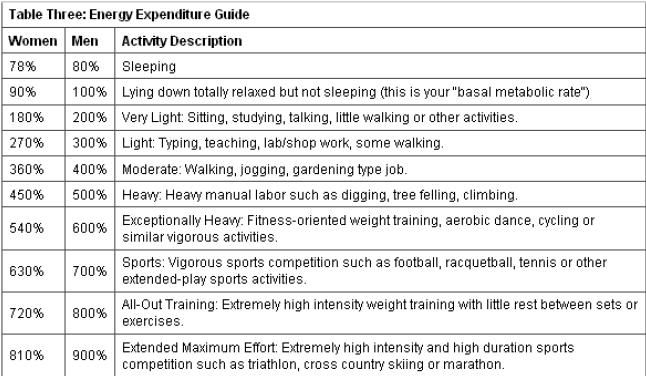
The higher your body fat percentage, the fewer calories you'll burn (lower activity level, and less muscle to burn calories). The lower your body fat percentage, the more calories you'll burn (bigger muscles burn more calories than little ones). Thus, it becomes much easier to get rid of fat permanently by increasing your metabolic rate. You do this by increasing both your muscle mass and your activity level. You can (and SHOULD) gain muscle mass and lose fat at the same time. Never sacrifice muscle tissue during the fat loss process. Instead, build more muscle to burn more calories. You'll lose more fat faster, and you'll be more likely to keep it off. The KEY is to control your calories!Wind, Rain, Phoenix
Hatfields FAQ
http://forum.bodybuilding.com/showthread.php?p=335396201&postcount=1#post335391691
-
-
05-27-2009, 02:55 AM #9TGZ

- Join Date: Apr 2006
- Location: Wellington, State / Province, New Zealand
- Posts: 810
- Rep Power: 2369












The "Quick Check" Method
The caloric expenditures listed in Table Two are for people with about a 20% body fat level. The smaller your muscles are, the fewer calories you'll burn; the bigger your muscles are, the more calories you'll burn. That means that the higher your proportion of fat is to your total body weight, the fewer calories you?ll burn. On the flip side of the coin, the greater your proportion of muscle to your total body weight, the more calories you?ll burn. Remember that strenuous exercise with weights (including dumbbells and barbells, Nautilus-type machines, your own body weight, and other forms of resistance exercises) is the best way to increase your muscle size, thereby increasing your metabolic rate. This will result in far more calories being burned all day long, even at night while you're sleeping. This, in turn, makes it easier to keep your body fat level in check.
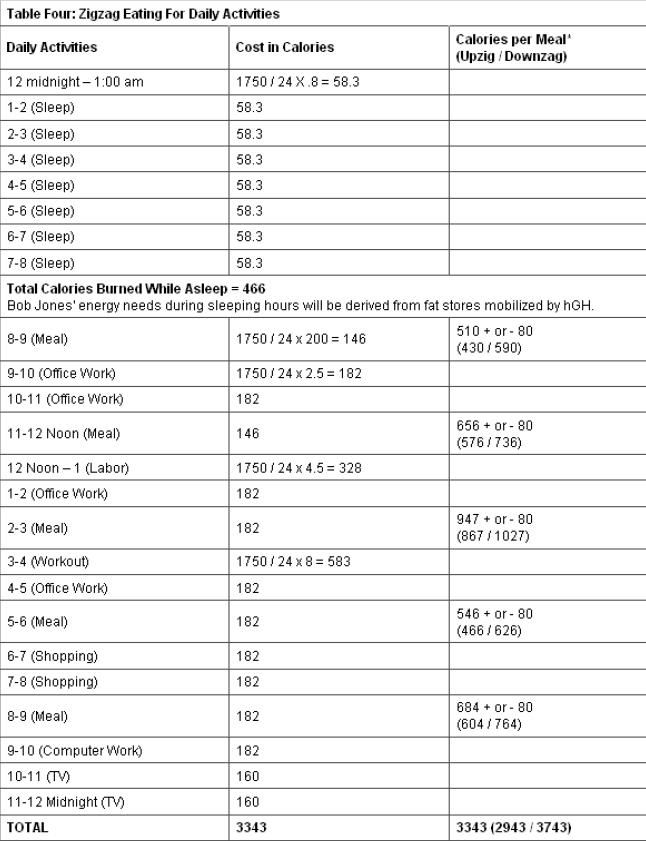 Wind, Rain, Phoenix
Wind, Rain, Phoenix
Hatfields FAQ
http://forum.bodybuilding.com/showthread.php?p=335396201&postcount=1#post335391691
-
05-27-2009, 03:01 AM #10TGZ

- Join Date: Apr 2006
- Location: Wellington, State / Province, New Zealand
- Posts: 810
- Rep Power: 2369












Determining Your Hourly Calorie Need
A more precise method for determining your caloric need is to compute it hour-by-hour.
For each of the 24 hours in your "average" day, determine your energy expenditure by reading the descriptions in Table Three. Then, multiply your hourly BMR (BMR divided by 24) times your energy expenditure.
For example, if Bob Jones? hourly BMR equals 85 calories, and his average activity level during that hour was 300 percent above BMR, you simply multiply 85 times 3.00. His hourly caloric expenditure equals 255 calories. Remember, most people intersperse each hour of heavy activity with brief quiescent periods (e.g., resting 5 minutes between sets or chatting with your training partner during a workout). Therefore, it is important to get an AVERAGE for that hour! You may have to break each hour of activity down into briefer periods for the sake of accuracy. Do this for each hour of the day, add all of them together, and that is your daily caloric requirement.
Be SURE to apportion your daily calories over at least five meals, with the size of each meal reflective of your UPCOMING caloric needs. For example, if you expect to train, eat more; if you expect to take a nap, eat less.
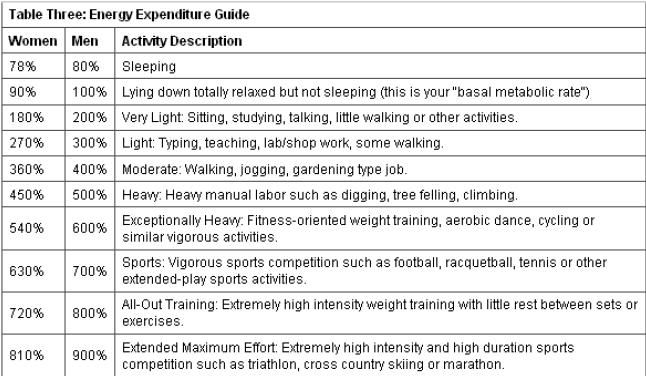
For example, Bob Jones weighs 161, and his lean body weight is 159 (fat weight is 9) with 5.7% body fat. His BMR is 1750. Let?s look at his day (Table Four).

* The caloric value of each meal is predicated on the caloric cost of upcoming activities. Then, approximately 400 calories are added to workout days and subtracted from days in which there is either no workout or workouts for smaller muscle groups. In this example, that would equal 80 calories added to or subtracted from each of 5 meals. This ?zigzag? pattern ensures both muscle gain and fat loss.Wind, Rain, Phoenix
Hatfields FAQ
http://forum.bodybuilding.com/showthread.php?p=335396201&postcount=1#post335391691
-
05-27-2009, 03:04 AM #11
-
05-27-2009, 03:05 AM #12
-
-
05-27-2009, 03:07 AM #13
-
05-27-2009, 03:10 AM #14TGZ

- Join Date: Apr 2006
- Location: Wellington, State / Province, New Zealand
- Posts: 810
- Rep Power: 2369












Q: What about drop sets for the 3x40 or the 10x10?
A:
In bodybuilding and weight training, using drop sets is a technique for continuing an exercise with a lower weight once muscle failure has been achieved at a higher weight. It is most often performed on weight machines because reducing the weight quickly is thought by some to be extremely important, but it can also be performed with dumbbells and other free weights.
Example
While performing a bicep curl, the person lifting the weight would start with a 25-pound dumbbell and do as many repetitions as possible without significantly compromising form. Then a 20-pound weight would be used until exhaustion is reached. One could continue to "drop" down as many times as he or she wishes.
So can you use drop sets to complete the 3x40 or the 10x10?
Yes you can, there is no reason why you can?t use the drop set method, remember nothing is set in stone. However I would not use it as a constant method performed on the above sets, but more of a muscle endurance and strength enhancer to help get you on your way to completing these sets using a constant weight throughout.
Using drop sets may also help you break through plateau's leading to increased weights when do these sets at a constant weight.
You could look to use drop sets every second to third workout as something new into the routine, this also gives you a good cardiovascular workout throughout all the reps as it gets your heart rate up. So you?re basically getting an interval cardiovascular workout while strength training.
The rational behind introducing drop sets in every second to third workout is that you want to break down your muscles and then let them repair/rebuild this is how you gain muscle.
If you break down your muscles with these intense exercises and never lay off you are not giving your muscles time to repair/rebuild. Hence you are losing muscle gains.
By following the A B C B A cycling and only using drop sets once or twice; through periodization you will allow enough time for targeted muscles used in your drop sets to rest/repair.
The way to insure you get the best benefits from using drop sets in your workout is to have a partner, they?ll be able to switch out the weights for you as quickly as possible so that you don't have to take time to rest in between the reps. You should not rest until the set is completely over.
Q: So if Drop Sets can be used, What about Negatives?
A:
One thing that's of note, most of the microtrauma (muscle tearing that causes delayed onset muscle soreness-and later hypertrophy) occurs during the eccentric phase of the negative movement. Concentrating on doing this on every set would almost certainly lead to over training-due to lack of proper recovery.
Hypertrophy (muscle building) occurs when the microtrauma is repaired, so compounding this over and over throughout your workout would most likely cause so much microtrauma that you'd never fully recover. During ANY type of high intensity weight training the minimum time between training the same muscle group is around five to seven days.
The use of negatives on this program will come down to timing, due to the stresses involved and the time required for recovery, using this principle on an already demanding program requires that you spread out your negative sessions, to one maybe two body parts per week. This is only a rough guide and not "Do as I say" approach.
Leave this to the advance lifters out there - You'll know if you are one of these guys.
I'll just stress two key factors if you decide to incorporate negatives:
1. Keep it to a minimum
2. Allow plenty of rest between sessions that incorporate the use of negatives
In saying the above, don't go and schedule a heavy day of 2 C set exercises right after the day your did your negatives, this will lead to over training.Wind, Rain, Phoenix
Hatfields FAQ
http://forum.bodybuilding.com/showthread.php?p=335396201&postcount=1#post335391691
-
05-27-2009, 03:14 AM #15TGZ

- Join Date: Apr 2006
- Location: Wellington, State / Province, New Zealand
- Posts: 810
- Rep Power: 2369












Q: How to best "personalize" this routine?
A:
The problem is, that each muscle group's tolerance to exercise probably differs. Each exercise you do for each body part can - and often does - possess entirely individual rep ability at 80 percent max. To discern your specific tolerance level for each body part,
follow these simple instructions:
1. Determine your approximate one rep maximum (1RM) for each exercise.
2. Load 80 percent on the bar (machine) & rep out with it for one all-out effort to see how many reps you can do.
3. Apply this information to the table below to determine each body part's exercise tolerance.
4. Take into account ALL of the factors listed above that can affect your exercise tolerance.
5. Critically evaluate whether your predicted exercise tolerance levels stand up to what you know from experience to be true. Remember, ?low tolerance? means that you probably make easy gains for that body part, and ?high tolerance? means that you?re probably a hard gainer for that body part.
Here is an example of in regards to exercise tolerances for fast gainers, average gainers and slow gainers. Perhaps you'll find these figures and estimations to be pretty close estimates, or perhaps you won't.
One thing is clear you must look! Your continued progress toward your maximum potential may well depend on it!
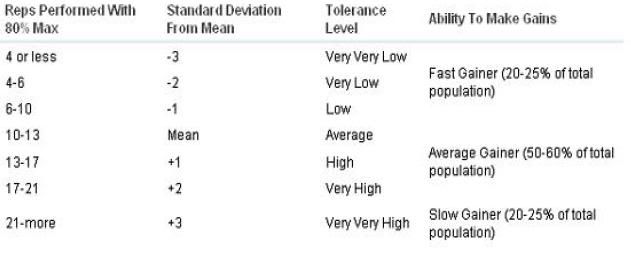
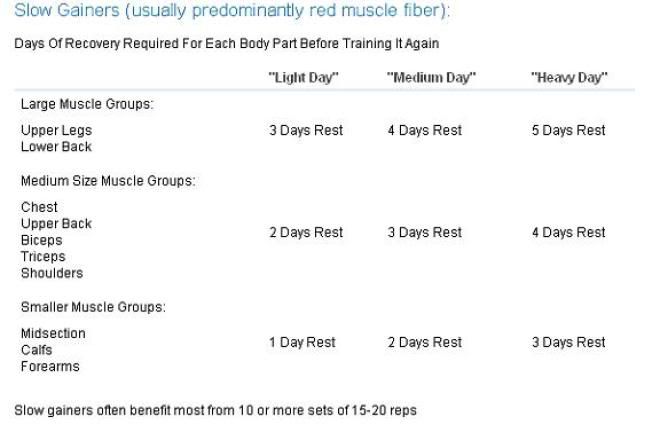
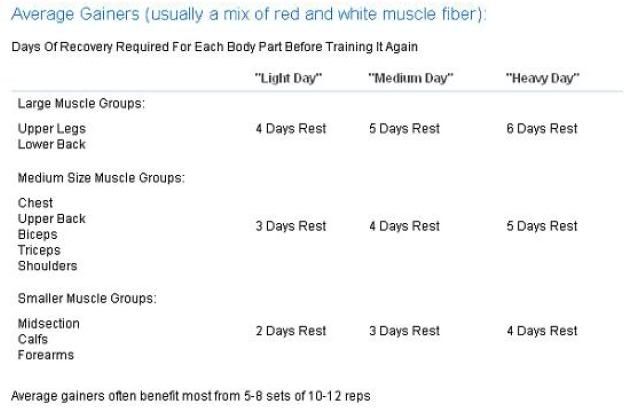
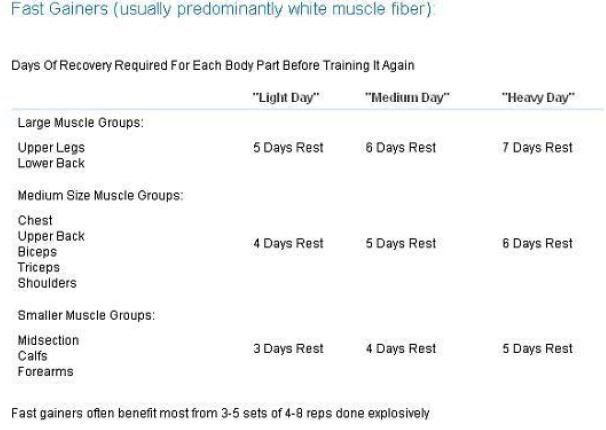
By critically evaluating your individual muscles' tolerance to exercise, you can more easily "fine tune" your training regimen to provide maximum gains in the shortest possible time. But don't forget the other factors that may affect your recovery rate. Look at the list again (above). How have you accounted for each of these variables? effect on your progress?
Have you raised or lowered your reps and sets accordingly? Have you increased or decreased the frequency of your workouts commensurably? Training intensity?
Have you taken into account your ratio of white versus red fibre, and adjusted your exercise load and movement speed accordingly?Wind, Rain, Phoenix
Hatfields FAQ
http://forum.bodybuilding.com/showthread.php?p=335396201&postcount=1#post335391691
-
05-27-2009, 03:16 AM #16TGZ

- Join Date: Apr 2006
- Location: Wellington, State / Province, New Zealand
- Posts: 810
- Rep Power: 2369












Q: Bad Workout? No Problem. Here's some tips
A:
One thing to keep in mind is that bad workouts don?t just happen; there is always an explanation. Lets look at a few of the factors outside of the actual training that may be contributing to your training problems and can be done about them.
1. Too much training, not enough rest
This seems pretty straightforward and it is a bit of a refresher from the repeated rest message through this document but this is advice that always bears repeating. For some reason, when it comes to grip training, many people tend to throw logic out the window. For example, it is a commonly held belief by many people that ?because the hands and forearms are small muscle groups they will recover faster and I can train them hard everyday.?
2. Sleep to grow
Are you getting enough sleep at night or staying up to the wee hours playing video games (or otherwise screwing around) when you should be resting? Several weeks of restful sleep every night can make you grow like a weed. Eight hours is recommended though I know that with so many things going on in your life, sometimes that just isn?t going to happen. For the amount of sleep you are able to get, try to make that as restful as possible.
3. Feed the machine
How about your diet, good wholesome food or pop and potato chips? A Ferrari isn?t going to run as well as it can when you pump it full of low quality fuel and neither will your body. If your diet is a case of Garbage in, garbage out then you have to make a change. There is nothing better than wholesome, real food. Also don?t make the mistake of trying to live off supplements only. They are called supplements for a reason, because they supplement the real food you eat.
4. Don?t underestimate the impact of stress from work/school/family etc.
Darn, there?s real life getting in the way of my workout again! With some things, you just have to do what you have to do. If you are under a lot more stress lately than you have had to deal with in the past, there is a good chance that you are going to have to adjust your workout. Of course a workout can be a great stress reliever on its own but don?t assume that you can train the same way under high stress situations than you did when things were going a lot smoother. For example during exam week, I always had to cut my workouts down by about half. I knew I had only so much energy to expend and needed to devote it to studying. That way I could keep making good progress in my workouts, even if in a few things, as well as get my studying done.
5. Alcohol or tobacco
You?d be better off dropping these altogether for a lot of reasons. I won?t go into all the ways that these will put a big time damper on your potential. It should be pretty obvious.
6. Active rest & cardiovascular work
There is no doubt that It is important to recover between workouts but you will actually hinder your progress by "veg-ing" out on the couch too often. I have always found that being somewhat active between workouts helps me to recover at a much greater rate. This helps get the blood pumping, warm up the joints and get rid of the lactic acid and other waste products in the blood. It doesn't take much even just a light jog can work wonders for this kind of thing.
7. Stretching and active rest for the hands
This one is building off #6 and is directed specifically toward hand and grip strength development. Yes, I feel the same rules apply as in #6, some active rest work between workouts will go a loooong way as far as enhancing your progress. BUT this kind of thing is very easy to put off and I know that I have that problem at times.
There are other factors but I would say these are the most straightforward.Wind, Rain, Phoenix
Hatfields FAQ
http://forum.bodybuilding.com/showthread.php?p=335396201&postcount=1#post335391691
-
-
05-27-2009, 04:32 AM #17
-
05-27-2009, 06:44 AM #18
-
05-27-2009, 07:00 AM #19
-
05-27-2009, 07:05 AM #20Abiad's Army

- Join Date: Oct 2008
- Location: Toronto, Ontario, Canada
- Age: 34
- Posts: 14,768
- Rep Power: 15033












Guys how long did this take you?? lol, holy crap, nice job!
Bench: 215x12 (17/12/2011) PR since torn RC
"Being the best in your circle is not enough; you have to think bigger to become a champion. Donít think like a small fish in a big pond or else when you get to the ocean youíll be eaten alive." - Fouad Abiad
"Proper preparation prevents poor performance," - Kai Greene
-
-
05-27-2009, 09:14 AM #21Team Ground Zero

- Join Date: Jan 2009
- Location: British Columbia, Canada
- Age: 47
- Posts: 387
- Rep Power: 346












-
05-27-2009, 12:06 PM #22
-
05-27-2009, 12:22 PM #23
-
05-27-2009, 12:45 PM #24
-
-
05-27-2009, 02:13 PM #25
-
05-27-2009, 02:41 PM #26
-
05-27-2009, 03:12 PM #27
-
05-27-2009, 03:40 PM #28
-
-
05-27-2009, 03:43 PM #29
I didn't read through it. Although it did take me a half an hour just to scroll to the bottom. I really need to learn how to work those other buttons on the keyboard.
Hint: If whatever you are posting takes up more space than is allotted in a single post just give us a link.
negged from kitarpyar:
Poor chap. Suffering from bad eyesight are you? See a doctor then. Wisest thing to do. As you put in your little "hint", there are a ton of links in the first post. But then of course, bringing in a negative vibe is your job, so have fun getting negsLast edited by SumDumGoi; 05-27-2009 at 04:10 PM.

-
05-27-2009, 03:45 PM #30Abiad's Army

- Join Date: Oct 2008
- Location: Toronto, Ontario, Canada
- Age: 34
- Posts: 14,768
- Rep Power: 15033












I hope you know that its people like you that hold back our world from reaching better things. No one asked you to come into this thread. No one asked you to post.
Yet here you are. If you don't like Hatfields program, or have no questions about it, stay out of this thread and stop causing problems.Bench: 215x12 (17/12/2011) PR since torn RC
"Being the best in your circle is not enough; you have to think bigger to become a champion. Donít think like a small fish in a big pond or else when you get to the ocean youíll be eaten alive." - Fouad Abiad
"Proper preparation prevents poor performance," - Kai Greene
Similar Threads
-
Iron Man Magazine Presents The BB.com Model Search Brought To You By BodySpace.
By BodySpaceAdmin in forum Company PromotionReplies: 525Last Post: 08-14-2009, 11:42 PM -
The creepiest pictures ever thread! I dare you to beat my pics!
By Hugh2 in forum Misc.Replies: 125Last Post: 11-07-2008, 01:42 AM






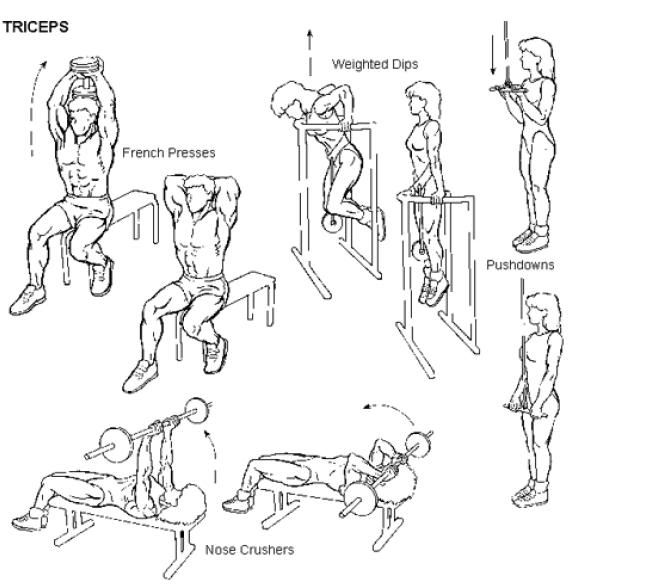
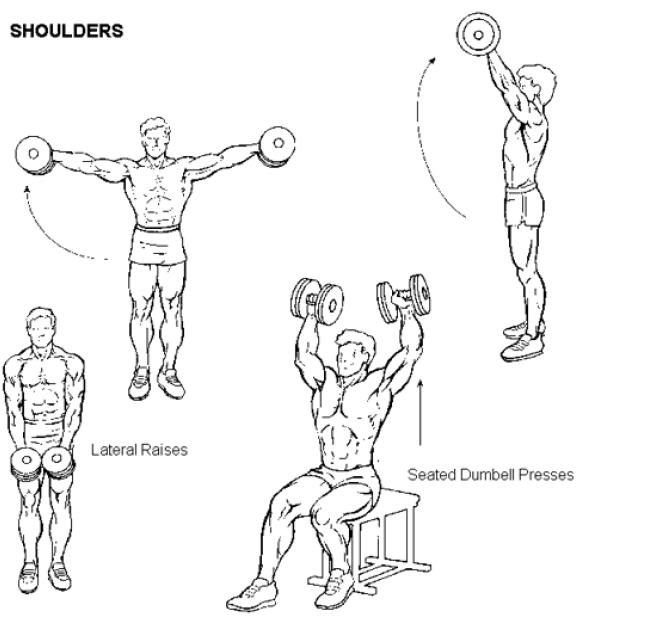
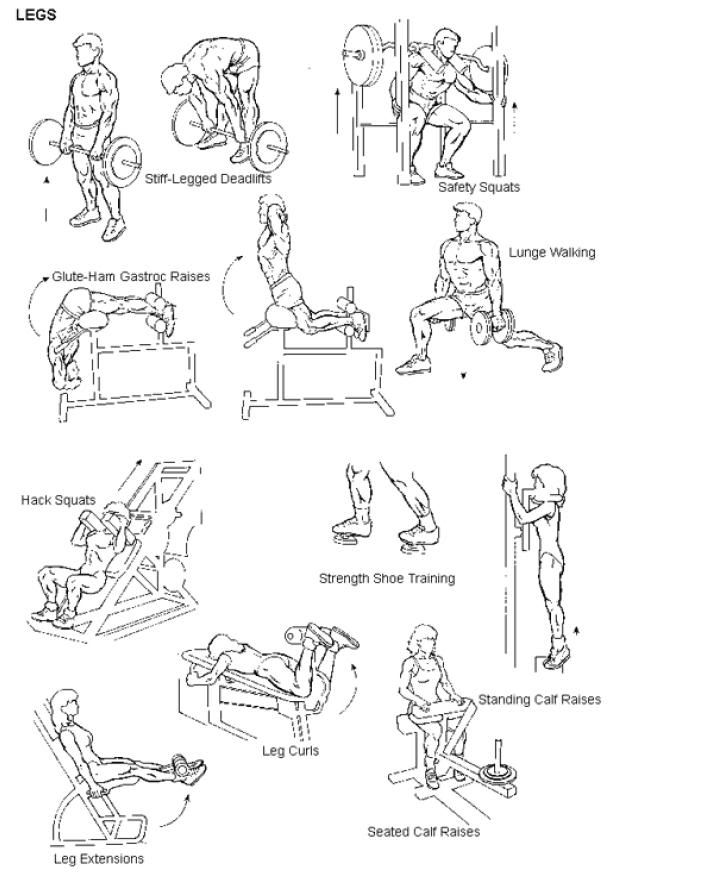
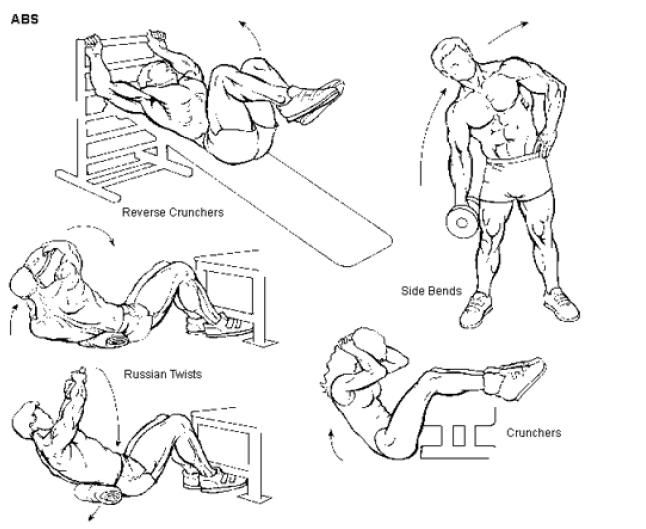
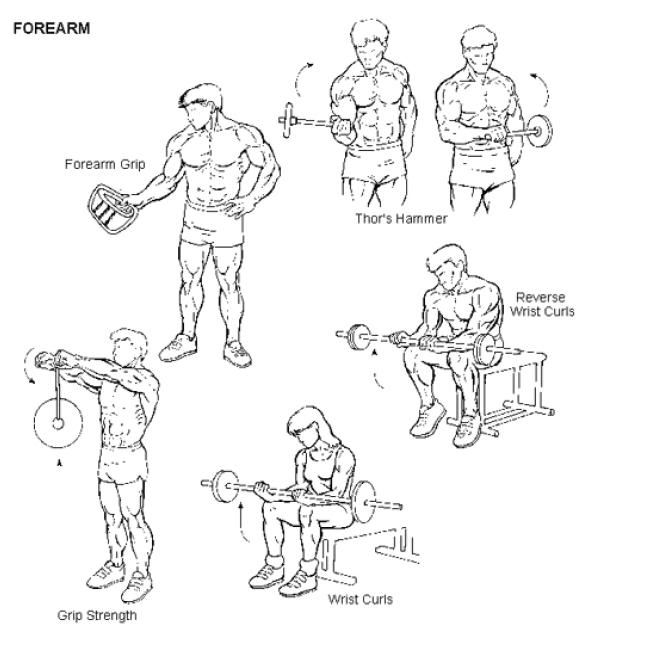
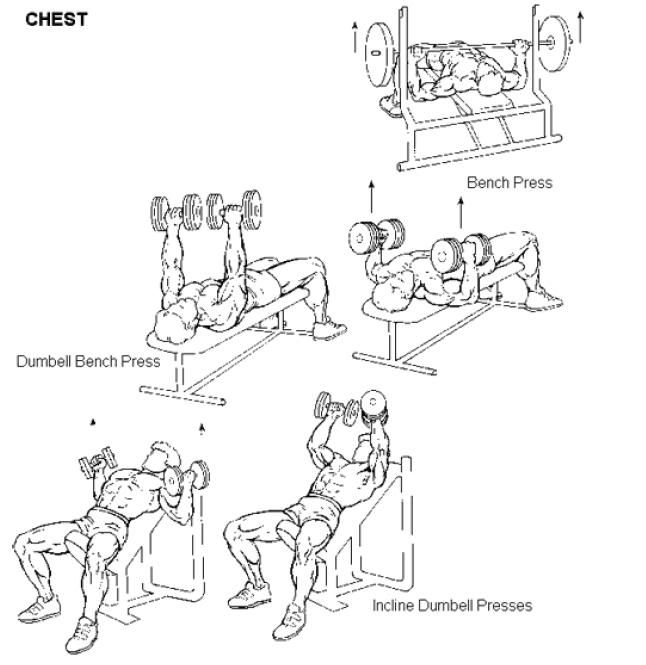
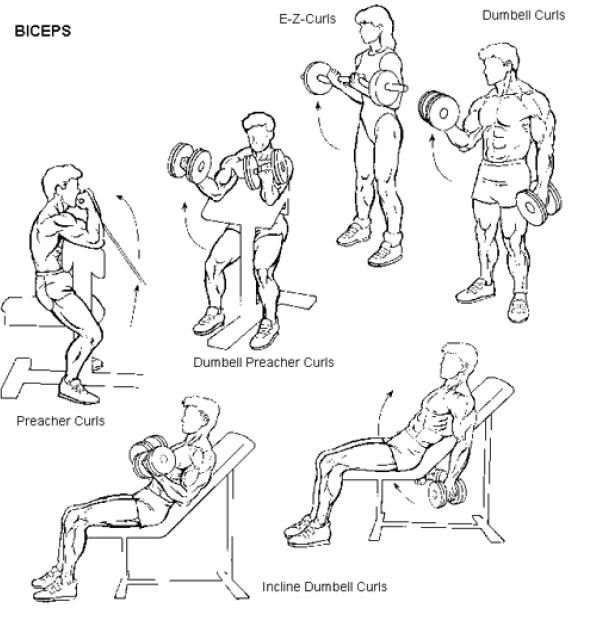
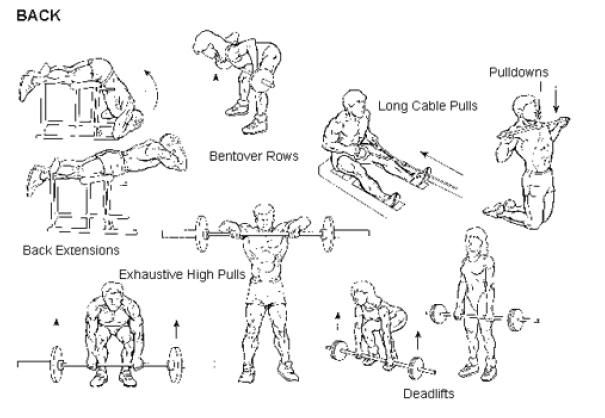







Bookmarks